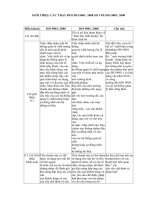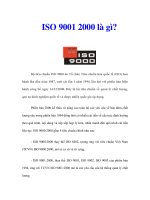customer satisfaction measurement and iso 9001 2000
Bạn đang xem bản rút gọn của tài liệu. Xem và tải ngay bản đầy đủ của tài liệu tại đây (113.23 KB, 5 trang )
Customer satisfaction measurement and ISO 9001:2000
The new BS EN ISO 9001:2000 standard has made customers the focal point of a
process based quality management system. To quote from the introduction to the
Standard:
“This International Standard promotes the adoption of a process approach when
developing, implementing and improving the effectiveness of a quality management
system, to enhance customer satisfaction by meeting customer requirements.”
The diagram, reproduced from the Standard shows customers, not management, as the
starting point of the quality management system. The role of management is “to
ensure that customer requirements are determined and are met with the aim of
enhancing customer satisfaction.” Management is also responsible for making
available adequate resources to enable the organisation to develop and deliver a
product (the standard uses ‘product’ to mean product or service), which will meet
those customer requirements. To judge the organisation’s success in achieving this
core objective, customer satisfaction will have to be measured and the results used as
a key ingredient for the continual improvement of the quality management system.
This type of “Plan-Do-Check-Act” process is a continuous one, creating the need to
identify customer requirements and measure customer satisfaction on a regular basis.
R
e
q
u
ir
e
m
e
n
t
s
C
u
s
t
o
m
e
r
S
a
t
i
s
f
a
c
t
i
o
n
C
u
s
t
o
m
e
r
Measurement
analysis
improvement
Management
responsibility
Resource
management
Product
realisation
In
p
ut
Product
Out
p
ut
Source of dia
g
ram: BSI
Figure 1: Model of a process-based quality management system (BSI, December
2000).
This series of six articles will firstly clarify the customer satisfaction measurement
(CSM) requirements contained in the new Standard before moving on to explain how
to set up a CSM system which will meet the requirements of ISO 9001:2000 as well
as providing a very reliable indicator of the extent to which your organisation is
meeting its customers’ needs.
The requirements of ISO 9001:2000
There are many references to customers in the new Standard, starting right at the
beginning where the Scope is defined in terms of meeting customers’ requirements
and using the quality management system to enhance customer satisfaction. The main
references to CSM in the new Standard are shown in Table 1 and examined below.
ISO 9001:2000, CSM requirements
Section Requirement
1. Scope
1.1 General
This International Standard specifies requirements for a quality
management system where an organisation:
a) Needs to demonstrate its ability to consistently provide
product that meets customer and applicable regulatory
requirements, and
b) Aims to enhance customer satisfaction through the effective
application of the system, including processes for the
continual improvement of the system and the assurance of
conformity to customer and applicable regulatory
requirements.
5. Management
responsibility
5.2 Customer
focus
Top management shall ensure that customer requirements are
determined and are met with the aim of enhancing customer
satisfaction (see 7.2.1 and 8.2.1).
6. Resource
management
6.1 Provision of
resources
The organisation shall determine and provide the resources needed
a) To implement and maintain the quality management system
and continually improve its effectiveness, and
b) To enhance customer satisfaction by meeting customer
requirements.
7. Product
realisation
7.2 Customer-
related processes
7.2.1 Determination of requirements related to the product
The organisation shall determine
a) Requirements specified by the customer, including the
requirements for delivery and post-delivery activities
8. Measurement,
analysis and
improvement
8.2 Monitoring
and measurement
8.2.1 Customer satisfaction
As one of the measurements of the performance of the quality
management system, the organisation shall monitor information
relating to customer perception as to whether the organisation has
met customer requirements. The methods for obtaining and using this
information shall be determined.
8.4 Analysis of
data
The organisation shall determine, collect and analyse appropriate
data to demonstrate the suitability and effectiveness of the quality
management system and to evaluate where continual improvement of
the effectiveness of the quality management system can be made.
This shall include data generated as a result of monitoring and
measurement and from other relevant sources.
The analysis of data shall provide information relating to
a) Customer satisfaction (see 8.2.1)
b) Conformity to product requirements (see 7.2.1)
Table 1: References to CSM in ISO 9001:2000
The main CSM requirements
(i) Scope and management responsibility
As previously indicated, customers play a pivotal role in the new Standard. The first
section on the scope of the Standard makes it clear that the central purpose of the
quality management system is to ensure that the organisation meets the needs of its
customers and continually strives to enhance customer satisfaction. Indeed, Section 5
places this responsibility firmly with senior management who must also ensure that
adequate and appropriate resources are provided to achieve this objective.
(ii) Customer requirements
Despite the importance of customer satisfaction, the Standard offers virtually no
advice on how it should be monitored. Section 7 stipulates that customers’
requirements must be determined, “including the requirements for delivery and post
delivery activities”. The implication of this very brief and somewhat misleading
phrase is that all aspects of the augmented product as well as the core product itself
must be covered. ISO 9000 (Fundamentals and Vocabulary) provides some additional
evidence. In the ‘terms and definitions’ section, ‘requirement’ is defined as “need or
expectation that is stated, generally implied or obligatory”. As we will see in Article
2, this rather loose use of the words ‘requirement’, ‘need’ and ‘expectation’ as though
they are inter-changeable is not conducive to good CSM practice. However, in general
terms the implication that customer requirements are all embracing is helpful. As we
will see next month, ‘customer requirement’ can include any factors on which
customers base their judgement of your organisation.
(iii) Customer satisfaction
Until the latter stages of the development of the revised Standard, it seemed that
organisations were to be required to do no more than monitor ‘customer satisfaction
or dissatisfaction’. This weak form of wording could have been addressed simply by
monitoring customer complaints, leaving the situation little changed from the old
Standard. Happily, this avoidance of any real obligation to satisfy customers was
rectified in the final version of the new Standard. Indeed, clause 8.2.1 provides a
commendable definition of customer satisfaction – “customer perception as to
whether the organisation has met customer requirements”. This aligns the Standard
firmly with the Tom Peters view that ‘perception is reality’. It is widely recognised in
the customer satisfaction field that customers’ perceptions do not always conform
with reality. Customers have very long memories for anything that has upset them and
it may take several good customer experiences to eradicate the negative attitudes
arising from one bad experience. The implication of this definition is that compliance
with the Standard’s requirement to monitor customer satisfaction can be achieved
only through asking customers about their level of satisfaction. Since the standard
also stipulates the use of recognised analytical and statistical techniques, it will be
necessary to formally survey customers rather than informally consult them during the
normal course of business. In Articles 3 and 4 we will examine how a customer
satisfaction survey can be conducted in a professional and reliable manner.
The transition to ISO 9001:2000
ISO 9001:2000 is now a live standard. Organisations seeking assessment of their
quality management system for the first time can be assessed to ISO 9001:2000 with
immediate effect and would be well advised to follow that course of action.
Developing a new quality management system to the old standard would not be a
sensible policy. Organisations who already have a system which conforms with ISO
9001:1994 or ISO 9002:1994 have a transition period during which they can continue
to be assessed to their existing quality management system. The International
Accreditation Forum has established a set of guidelines for Certification Bodies and
this includes a maximum transition period of three years from publication of the new
standard, which was published in December 2000. However, that is the maximum
time period allowed, and registered companies are strongly advised to contact their
own certification body to agree a suitable transition time for their own organisation.
For organisations that have not previously measured customer satisfaction, developing
that capability will be one of the more challenging requirements of the new Standard.
It would be advisable to use 2001 to develop and introduce a professional and reliable
CSM process prior to incorporating that process into the quality management system
for later assessment. It is important however, that your transition plan is agreed with
your certification body.
The remaining articles in this series will explain how to develop and implement a
CSM process in your own organisation. Topics covered will include:
Article Topic
2 Identifying customer requirements
3 Conducting the survey (1): Questionnaire design and sampling
4 Conducting the survey (2): Data collection and analysis
5 After the survey: Communicating the results and taking action
6 Moving beyond ISO 9001: CSM and ISO 9004







